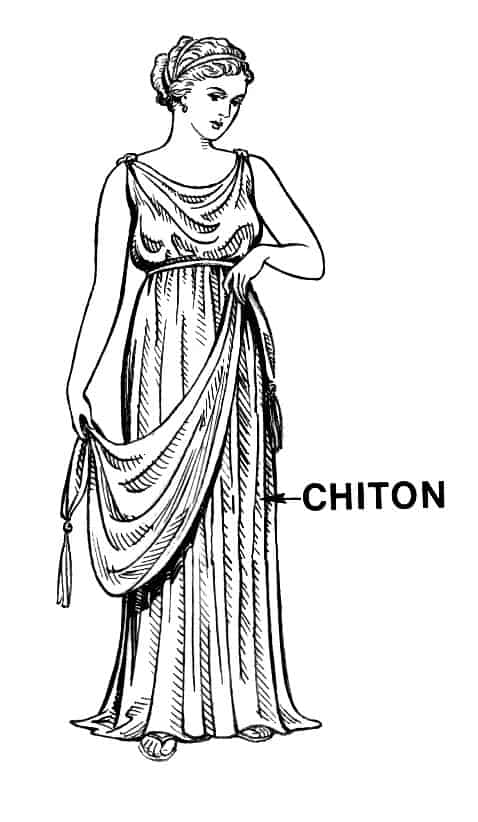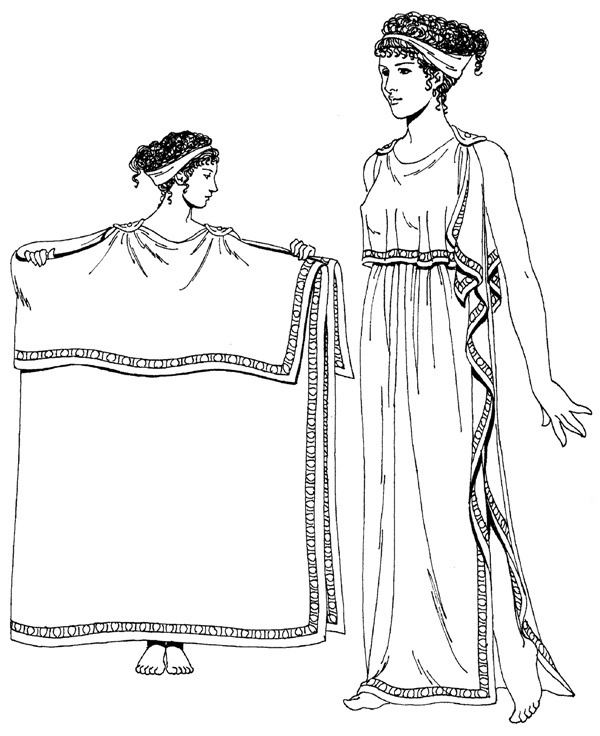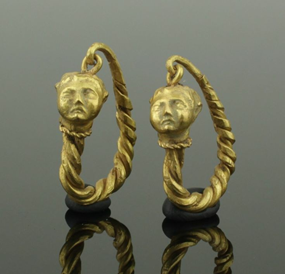Written By- Nikita Rajani
Guided by Ms Monika Malik
INTRODUCTION
Greek civilisation started from 700 BC and lasted till 53 BC. It was mainly based on necessity, function, materials and protection. Clothes were quite simple in the form of drape, fluid, free flowing and loose-fitting. during ancient Greek civilisation clothes that were worn were handwoven and were influenced by the clothing of ancient Egyptians. In other words, the piece of clothing was ancient version of modern day cloaks and wrap around, fluid draped and nudity depending on the place and occasion.
For the poorer and lower classes, garments were plain coloured, white or reddish-brown. The upper classes used dyes and decorated clothing with simple borders or all-over patterns and embroidered in multiple colours. Social hierarchy used to establish by easily recognisable form for both men and women in an outfit called Chiton.

Chiton was draped cloth, fastened on the shoulders with pins and brooches known as Fibulae. It was left open at the side and wrapped around the body. The wearing of the Chiton developed into sophisticated forms of folding, twisting and wrapping. Belts and girdles were worn on the waist or hips. Accessories included hats, walking stick, gloves and leather sandals.
WOMEN’S CLOTHING
The clothes worn by women in Ancient Greece was a long tunic called the Peplos. It was a long piece of cloth that was fastened at about the waist with a belt. Peplos was worn over chiton. It often featured brightly coloured woven patterns of wavy lines, oval shapes, animal and scenes. At first wool was a favoured fabric but this later changed to lighter textiles such as linen, occasionally silk, cotton and flax fibre known as Byssus.

The outermost garment worn by both men and women was the Himation. Himation was another rectangular fabric initially worn as a cloak around the shoulder, it later developed into an elaborately draped garment often worn over the head.

Women’s hairstyles were delicate and complicated- chignons, braids, ringlets and sometimes hair was bleached.

MEN’S CLOTHING
Men generally wore chiton tunic which was sometimes shorter than the women’s tunic. Men also wore Himation which was sometimes worn without chiton.

Himition is a floor length garment which is worn behind the back and draped around the shoulder in a similar way a chiton is worn. They usually used to sew lead weights at the end of their garment, which helped them sway their body movements.

Instead of regular Himation, warriors and travellers sometimes used to wear a shorter garment commonly known as Chlamys over the Chiton.

Men’s hair were curled to frame the face , tied back and were often bearded. Unrestrained use of jewellery was common.

Both men and women wore numerous jewellery including gold chains, pendants, rings, bracelets and jewelled pins.

INFLUENCE ON TODAY’S FASHION
Ancient Greek culture has influenced modern designers over and over again. Modern interpretation of Greek costumes has an amazing and graceful look. Sheer, light and draping Greek inspired elements which brings together the power of femininity and elegance.

A cylindrical piece of cloth can be made into a dress and a top with a morphing neckline. A little black dress can be worn forward, or backward with caped sleeves. Cone shaped cloth can be converted into a shirt and skirt which has no front or back and can we worn both ways. Designer’s nowadays captures Ancient Greek beauty with elegant draped shapes to revive classically fluid forms in their designs.

With a flurry of ruffles, pleats, and drapes, Greek clothing displays a spectacular look in fashion shows. The most interesting aspect of Grecian clothing is that it can be twisted, tied, and wrapped to create different outcomes and looks.

In 2011, Gaultier exhibited Greek inspired originally pleated gown:

The classic chiton is extremely popular among designers as well as celebrities who have given it new life in today’s fashion. One shoulder gown is popularly increasing trend.

Versace spring 2015 Greek Men’s inspired runway looks:


Greek inspired footwear:


Greek inspired jewellery:


Greek clothing styles were very elaborated and way ahead of their time. Modern fashion designers have acquired a lot of inspiration from Ancient Greeks. They are loved for its beauty and simplicity.
I hope this blog was an informative read. For more such insightful blogs, keep reading and supporting.
Do follow, comment,share & like!!


